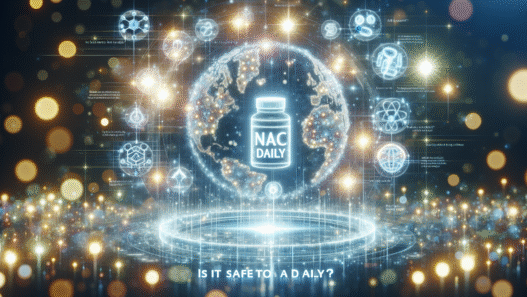Understanding NAC
Introduction to N-Acetyl Cysteine
N-Acetyl Cysteine (NAC) is a derivative of the amino acid cysteine and is known for its diverse health benefits. It is most recognized for its role as a precursor to glutathione, a powerful antioxidant that helps combat oxidative stress in the body. As people become more concerned about longevity and overall well-being, NAC has garnered attention for its potential implications in aging, liver health, and detoxification.
NAC is available as a dietary supplement and can also be found in various health products. People interested in optimizing their health, particularly those focused on n-acetyl cysteine benefits, may consider adding this supplement to their regimen.
Mechanism of Action
NAC operates through several mechanisms that contribute to its health benefits. One significant action involves its ability to increase intracellular levels of glutathione (GSH), which plays a vital role in maintaining redox balance. Elevated GSH levels assist in neutralizing free radicals, thereby mitigating oxidative stress. Moreover, NAC has been shown to reduce the production of inflammatory cytokines, including TNF-α, IL-6, and IL-1β, by inhibiting the activity of nuclear factor kappa B (NF-κB) (NCBI).
In summary, NAC enhances the body’s antioxidant defenses while reducing inflammation, making it a valuable compound for those interested in n-acetyl cysteine and aging and overall health. To explore more about its benefits on skin and aging, check out nac for skin health and nac for anti-aging.
Health Benefits of NAC
N-Acetyl Cysteine (NAC) is a powerful compound known for its numerous health benefits, particularly related to oxidative stress, disease prevention, and liver health.
NAC and Oxidative Stress
NAC plays a crucial role in the production of glutathione, one of the body’s most important antioxidants. By enhancing glutathione levels, NAC helps to combat oxidative stress by neutralizing harmful free radicals. This process is vital in reducing the risk of various health conditions such as heart disease, diabetes, and infertility (WebMD).
The potential to alleviate oxidative stress can be illustrated in the following table:
| Health Condition | Impact of NAC |
|---|---|
| Heart Disease | Lowers oxidative stress; may reduce risk |
| Diabetes | Aids in managing oxidative stress related to insulin resistance |
| Infertility | Reduces oxidative damage to reproductive health |
NAC in Disease Prevention
Studies suggest that NAC may aid in preventing diseases linked to inflammation and oxidative stress. It has shown potential benefits in reducing inflammation, improving insulin sensitivity, and influencing fat metabolism and hormonal balance. While ongoing research continues to validate these findings, early studies highlight NAC’s promising effects concerning obesity and associated health conditions.
| Disease Category | Potential Benefits of NAC |
|---|---|
| Inflammation | Reduces inflammatory markers |
| Obesity | Improves insulin sensitivity and metabolic function |
NAC for Liver Health
One of the most well-documented uses of NAC is for liver health, particularly in the treatment of acetaminophen overdose. NAC works by boosting glutathione levels, which aids in breaking down the acetaminophen and preventing severe liver or kidney damage when administered promptly after an overdose.
Additionally, NAC contributes to overall liver function by helping to detoxify harmful substances and may support various metabolic processes.
| Function | Role of NAC |
|---|---|
| Detoxification | Aids in the breakdown of toxins including acetaminophen |
| Liver Support | Promotes healthy liver function through glutathione enhancement |
NAC’s broad spectrum of benefits emphasizes its significance in promoting better health and combating age-related issues. For more information on its potential effects on aging, consider exploring n-acetyl cysteine and aging.
Clinical Applications of NAC
N-Acetyl Cysteine (NAC) has a variety of clinical applications that highlight its significant health benefits. This section will discuss its use in treating acetaminophen overdose, respiratory health benefits, and cardiovascular advantages.
Acetaminophen Overdose Treatment
NAC is most well-known for its role in treating acetaminophen overdose. It boosts glutathione levels in the liver, which is crucial for breaking down acetaminophen, thereby preventing liver or kidney damage when administered promptly—ideally within eight to ten hours of ingestion. This timely intervention can be lifesaving and illustrates NAC’s critical role in emergency medicine.
| Treatment Window | Outcome |
|---|---|
| 8-10 hours post-overdose | Prevents liver/kidney damage |
Respiratory Health Benefits
NAC also offers considerable respiratory health benefits. It acts as a mucolytic agent, thinning mucus in the airways, which aids individuals suffering from chronic respiratory conditions, including chronic obstructive pulmonary disease (COPD) and cystic fibrosis. Research suggests that NAC can enhance lung function and alleviate symptoms associated with these conditions, making it a valuable adjunct therapy for respiratory health.
| Condition | NAC Effect |
|---|---|
| Chronic Bronchitis | Reduces mucus viscosity |
| Cystic Fibrosis | Improves lung function |
Studies indicate that NAC can improve the quality of life for those suffering from chronic respiratory disorders and plays a role in reducing oxidative stress within lung tissues.
Cardiovascular Benefits
NAC shows promise for cardiovascular health as well. It has been noted for its potential to lower homocysteine levels—high levels of this amino acid are associated with an increased risk of cardiovascular disease. Furthermore, NAC has anti-inflammatory properties and can enhance endothelial function, which is vital for vascular health.
| Cardiovascular Indicator | Effect of NAC |
|---|---|
| Homocysteine Levels | Reduces levels |
| Endothelial Function | Improves function |
It is helpful for those considering supplements for n-acetyl cysteine and aging as it may lead to longer-term cardiovascular benefits.
NAC’s wide range of applications highlights its importance beyond mere supplementation, especially for those concerned about liver health or seeking longevity. For further reading on NAC’s benefits, visit our page on n-acetyl cysteine benefits and explore specific uses such as nac supplement benefits.
NAC Research Studies
Research studies involving N-Acetyl Cysteine (NAC) have expanded significantly in recent years, highlighting its potential efficacy in various health contexts, particularly regarding aging and its associated benefits.
Studies on NAC Efficacy
NAC has gained attention for its diverse range of health benefits, particularly in liver health and detoxification. It has been scientifically proven to be effective in treating acetaminophen overdose by boosting glutathione levels. This helps in breaking down acetaminophen, preventing liver or kidney damage when treatment is initiated within eight to 10 hours of an overdose (WebMD).
Additionally, research indicates that NAC supplements may assist in balancing blood sugar levels in individuals with insulin resistance, such as those with polycystic ovary syndrome (PCOS). However, it may not have a significant impact on blood sugar control for individuals with type 2 diabetes.
Furthermore, a pilot study indicated positive effects of NAC supplementation in male subclinical hypogonadism, suggesting potential enhancements in hormonal health and overall wellness (Minerva Endocrinol (Torino)).
GlyNAC Supplementation Findings
GlyNAC, a formulation of glycine and NAC, has shown promising results in research focused on aging. Studies revealed its potential to improve aging biomarkers and enhance overall health in older adults. Specifically, GlyNAC supplementation has demonstrated improvements in metabolic health, oxidative stress reduction, and mitochondrial function, which can be critical in geroprotective strategies.
A key finding reported in recent research is a significant enhancement in the cellular antioxidant status following GlyNAC supplementation, thereby potentially mitigating oxidative stress that contributes to aging (PubMed Central). This reinforces the understanding that n-acetyl cysteine and aging hold a synergistic relationship in promoting longevity and health maintenance.
Overall, ongoing studies continue to explore the therapeutic applications of NAC and GlyNAC, expanding the horizon for potential use in health-related strategies, particularly for those seeking n-acetyl cysteine benefits related to aging and longevity.
NAC and Aging
Effects on Aging Biomarkers
N-Acetyl Cysteine (NAC) has shown promise in influencing aging biomarkers and delaying age-related degeneration. A notable study indicated that continuous administration of NAC significantly increased both the average and maximum lifespan of Bmal1-deficient mice. The average lifespan extended by approximately 24%, while the maximum lifespan extended by 14%.
The benefits of NAC are closely linked to its ability to reduce levels of reactive oxygen species (ROS), a significant contributor to age-related tissue degeneration. Age-related increases in ROS can lead to oxidative stress, which has been associated with various signs of aging. By mitigating this oxidative stress, NAC helps delay the onset of aging, promoting longevity and overall health.
| Parameter | Control Group | NAC-Treated Group |
|---|---|---|
| Average Lifespan | – | +24% |
| Maximum Lifespan | – | +14% |
| Maximal Body Weight Loss (40 weeks) | 20% | 4% |
Geroprotective Effects
The geroprotective effects of NAC extend beyond merely increasing lifespan. Administration of NAC in trials demonstrated a significant reduction in age-associated weight loss among Bmal1-deficient mice. While the control group experienced a weight loss of 20% by 40 weeks of age, NAC-treated mice lost only 4% of their maximal body weight during the same period (PMCID).
Furthermore, data suggests that NAC administration improves survival rates as well. In the same study, 90% of NAC-treated mice survived until 36 weeks, whereas only 50% of the control group reached that age. These findings emphasize NAC’s potential as a tool for enhancing longevity and improving health as individuals age.
In addition, GlyNAC supplementation has been shown to be safe and well-tolerated among older adults, providing a combination of benefits that include addressing age-associated abnormalities (PubMed). This highlights NAC’s role not only in aging prevention but also in promoting overall health among aging populations.
The underlying mechanisms of NAC reveal its importance in the field of longevity and health. For more insights into the benefits of NAC, visit our section on n-acetyl cysteine benefits and learn about nac supplement benefits.
NAC Safety and Usage
Administration and Dosage
N-Acetyl Cysteine (NAC) can be administered through various routes including orally, intravenously, or by inhalation. It has a well-established safety profile, even in high doses. Following intravenous administration, the volume of distribution (Vd) of NAC ranges from 0.33 to 0.47 L/kg.
NAC is typically dosed based on individual needs and health conditions. For those interested in the specific dosage guidelines, it is advised to consult healthcare professionals or refer to the n-acetyl cysteine dosage resource for detailed information.
| Administration Route | Dosage Range | Comments |
|---|---|---|
| Oral | 600 mg – 1800 mg/day | Commonly recommended for general antioxidant support |
| Intravenous | 150 mg/kg for acute interventions | Used in emergency situations such as acetaminophen overdose |
| Inhalation | 3 – 10 mL (20% solution) | Often for respiratory conditions |
Safety Profile and Side Effects
NAC is considered to have a favorable safety profile. However, as with any supplement, potential side effects may occur. Some people may experience gastrointestinal discomfort, including nausea, vomiting, and diarrhea. Rarely, allergic reactions can occur, particularly in individuals with sensitive systems. In patients with severe liver injury, pharmacokinetics of NAC may alter due to reduced clearance rates. For instance, patients with end-stage renal disease (ESRD) show a significantly reduced total clearance of NAC by 90%, affecting systemic exposure and half-life.
| Possible Side Effects | Frequency |
|---|---|
| Nausea | Common |
| Vomiting | Less common |
| Diarrhea | Common |
| Allergic Reactions | Rare |
While NAC is often associated with beneficial effects, those taking it should monitor their response carefully and consult healthcare practitioners, especially if there are pre-existing conditions, such as chronic liver disease or psychiatric disorders. NAC has potential as an adjunct therapy for psychiatric illnesses, demonstrating safety and effectiveness in improving clinical outcomes for conditions like schizophrenia, bipolar disorder, and depression.
For further insight into the advantages of NAC, visit our sections on n-acetyl cysteine benefits and nac supplement benefits.





















